
How Domesticated Cattle Changed Life in Çatalhöyük
Those who have studied Çatalhöyük are aware that cattle appear to have been a hugely important animal in the Neolithic Central Anatolian town of Çatalhöyük East on the Konya Plain in modern-day Turkey. Since the site’s initial excavation in the mid-20th century, images of its wall- and platform-mounted bull horns and heads have captured the imagination and helped define the evocativeness of a settlement also known for its floor burials and plastered human skulls.
The magnificent aurochs -- the flesh-and-blood beast that inspired so much awe, storytelling, and mythmaking -- survived in wild form into historical times, petering out in the 17th century. Of the fertile repository of Bos remains unearthed across the levels of Çatalhöyük, the question of what is wild (aurochs) and what is domestic cattle (taurine) has occupied much research. Here, we’ll examine how the practical use of cattle changed substantially over the history of the settlement.
What Caused the Appearance of Domestic Cattle at Çatalhöyük?
In a 1969 report evaluating Çatalhöyük’s treasury of animal bones, Dexter Perkins suggested the site’s dwellers domesticated cattle, a conclusion he based on the reduction in the size of bovine skeletal remains. A decline in body size is one of the general hallmarks of domestication; so is, among cattle, smaller horns with a greater variety of shapes.
The idea that Çatalhöyük in Turkey was a regional center for cattle domestication, however, has been dismantled in recent decades. Further excavations at the site as well as others in Anatolia and the Levant, plus flaws revealed in Perkins’s biometric analysis, help explain that shift in understanding.
- Two Major Discoveries at One of the First Urban Centers, Çatalhöyük
- Revelations From Çatalhöyük: A 9,000-Year-Old Community With Modern Urban Problems
Unlike at some other regional Neolithic sites such as Cayönu Tepesi, where cattle seemed to steadily decline in size over millennia, small and otherwise morphologically domestic cattle make a fairly sudden appearance in the later levels of Çatalhöyük and at the nearby Central Anatolian settlement of Erbaba.
This would seem to suggest the acquisition of cattle domesticated elsewhere via trade. The current prevailing theory suggests domestic cattle were introduced to Çatalhöyük sometime between 6300 and 6000 cal BC.
Evidence for domestic cattle in the later levels at Çatalhöyük include not just smaller-bodied bovines and different horn shapes, but also changing sex ratios, with a greater proportion of cow remains as compared with earlier levels, as well as a pronounced shift in the culling of younger animals, another hallmark of active husbandry.
Furthermore, while beef (if you will) remains a feast food in the Late and Final phases at Çatalhöyük, evidence suggests cattle were also consumed in more everyday fashion at this point.
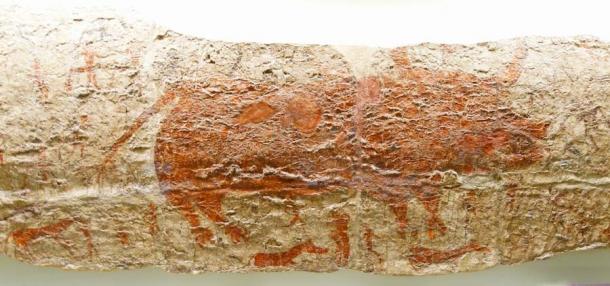
Original Çatalhöyük wall paintings depicting cattle hunting scenes. (cascoly2 / Adobe Stock)
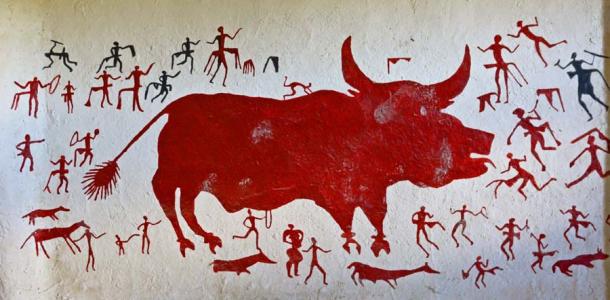
Reproduction of hunting cattle scenes from Çatalhöyük wall paintings. (The Cheroke / Adobe Stock)
Proto-Domestication, Herding, and Hunting
The absence of morphologically domestic animals up until later stages of occupation at Neolithic Çatalhöyük doesn’t preclude the possibility that the human populace here managed cattle to some degree.
Indeed, evidence of the earlier domestication of sheep and goats in Central Anatolia, and patterns seen in animal domestication elsewhere, support the notion that “pre-domestication management” -- also known by such terms as incipient domestication and proto-elévage -- may bring ungulates into some level of human control well before morphological changes in said animals become evident.
It’s possible that the Çatalhöyükians were inching in the direction of genuine cattle domestication when the smaller cattle tamed elsewhere (perhaps the southern Anatolian coast or the northern Levant) showed up.
Morphologically wild (aka large) and domestic (aka small) cattle overlap broadly at Çatalhöyük. It has been proposed that Bos proto-elévage may have been underway for some time at Çatalhöyük before domestic cattle were acquired and that the continued presence of large-bodied, large-horned animals may indicate the desirability of such “wild” traits to the society.
While direct evidence is lacking, researchers have speculated that semi-management of aurochs at Çatalhöyük could have involved some degree of penning. Perhaps aurochs cows and calves were foddered and penned at night but also allowed to graze natural pastures by day. The cows could thus be bred by wild bulls, helping maintain those coveted physical traits within a semi-managed population.
A Mix of Domesticated and Wild Cattle
Based on certain Çatalhöyük wall paintings, researchers have raised the possibility that residents might have penned wild aurochs bulls before a ritualized killing, rather than simply dispatching the beasts in the hinterland. Needless to say, this would have been quite the undertaking. It may also have been another means of maintaining wild-type traits in tamed cattle, as Arbuckle and Makarewicz (2009) note:
The presence at Çatalhöyük of wall paintings that may depict captured wild cattle suggests that Neolithic hunters may have at least occasionally brought aurochsen under control in order to provide high value and symbolically powerful animals for specific cultural events. If this highly risky and presumably socially rewarding behavior continued following the importation of domestic cattle at the site, it is possible that wild individuals, especially bulls, were allowed or encouraged to breed with domestic females, a practice that would effectively reduce the pace of phenotypic divergence within those domestic populations.
What seems clear is that the hunting of aurochsen -- a Çatalhöyük practice that preceded the adoption of domestic cattle here by at least a millennium -- remained important at the site even as some version of cattle husbandry was going on, and even as apparently fully domesticated cattle were being herded in other parts of the Near and Middle East.
In his 2016 work Studies in Human-Thing Entanglement, Ian Hodder, who’s overseen the Çatalhöyük Research Project for decades, suggests that the big, heavy-bossed aurochs bulls -- and the high-risk killing of them -- may have retained great symbolic and ritualistic significance amid changing lifeways. “Even if managed in some way,” he writes, “it is clear that the ‘wild’ and ‘hunted’ aspects of bulls were valued.”
Indeed, some recent scholarship proposes that the tradition of hunting aurochs and the ritualistic rites and prestige associated with it may have formed something of a bulwark against the adoption of domestic cattle at Çatalhöyük.
Arbuckle and Makarewicz (2009) note that morphologically domestic cattle are evident at Erbaba Höyük -- just a stone’s throw (relatively speaking) from Çatalhöyük, near Lake Beysehir -- around 6600 to 6500 cal BC, well before they were prominent at Çatalhöyük.
The apparent delay of several centuries between the appearance of domestic cattle at Erbaba and their adoption at Çatalhöyük may be related to the central role of aurochs hunting at the latter settlement...
Some of the inhabitants of Çatalhöyük, whose social position and identity may have been maintained by and deeply embedded within the practices surrounding hunting, may have actively resisted the ideological as well as the economic changes associated with incorporating cattle into the domestic sphere.
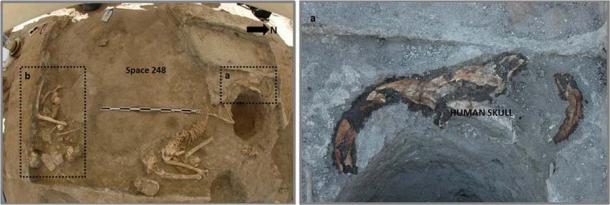
Çatalhöyük burial in Space 248 includes a woman’s skull placed together with the bucranium of what matches a morphologically domestic Bos. (Çatalhöyük Research Project / CC BY-NC 4.0)
The Waning of the Wild Bull
The great wild bull’s hold on Çatalhöyük society did appear to wane, part of a broadscale shift in cultural practices apparent in the Çatalhöyük East’s Final Phase during the Late Neolithic. Domestic cattle remains begin to predominate over aurochs in feasting deposits; bull horns fade as architectural fixtures, as do other wild-animal parts. Houses grew in size, and the practice of house burials ebbed.
“It is at this point in the later 7th millennium at Çatalhöyük that we finally see domestic animals and plants being used as the primary basis for building households and community relations,” Hodder writes in Studies in Human-Thing Entanglement.
In her Archaeological & Anthropological Sciences article, Pawlowska notes an intriguing later Çatalhöyük burial in Space 248: a woman’s skull placed together with the bucranium of what matches a morphologically domestic Bos.
She points out that animals buried with human remains elsewhere in the Neolithic Near East “are often domestic, nonthreatening, or young,” which may reinforce the identity of this bucranium as domestic rather than wild in origin. “But more importantly,” she writes, “this implies a new kind of relationship between humans and cattle hitherto unknown in Çatalhöyük.”
In Studies in Human-Thing Entanglement, Ian Hodder ponders whether the adoption of domestic crops and animals by Neolithic cultures in the Near and Middle East didn’t initially support, rather than replace, a hunting tradition. Hunting, he notes, likely served as much more than a nutritional effort; it was freighted with important ritualistic and societal meaning.
Perhaps, initially, cultivated plants and livestock lacked such multidimensional power and more importantly served as a kind of dietary foundation backing up the more culturally significant hunting of wild -- or perhaps symbolically wild, if semi-managed -- animals.
“As investment in hunting rituals of various types increased,” Hodder writes, “dependence on domestic sources of food would have supported larger-scale events associated with hunting. Hunts could become more risky and elaborate if the buffer of domestic cereals and sheep and goats existed.”
The Accumulation of Animal Wealth
A 2013 report on Çatalhöyük mammal remains observes that, post-domestic cattle, aurochs-hunting may have continued to be a route to prestige. “Hunting symbolism intensifies in these later levels even as wild animals (and hence hunting) become less common,” the authors note.
But it also proposes that, at this late stage, the hunting of wild bulls may have been less important in certain households than others; some may have focused more on cattle herding “and the accumulation of animal wealth” for social status.
Hodder’s Studies in Human-Thing Entanglement notes the inherent conflicts between crops/livestock and wild animals and the lifeways they support may have tipped the balance in the favor of agriculture and herding for Neolithic societies. “In the end,” he writes, “the focus on hunting declined in the Pottery Neolithic as the entanglements of farming became increasingly demanding.”
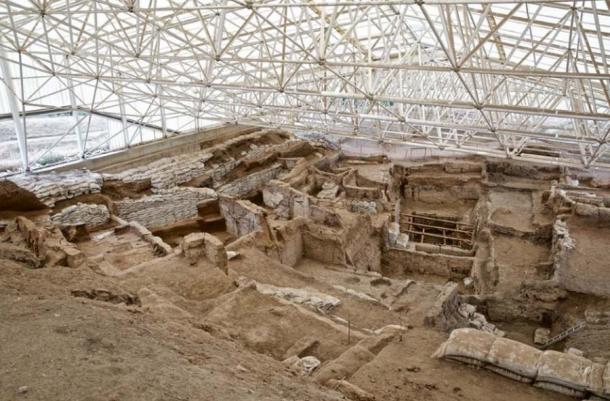
The excavations at Çatalhöyük reveal a honeycomb city as visible in this image of the south area excavation back in 2015. (Çatalhöyük Research Project / CC BY-NC-SA 2.0)
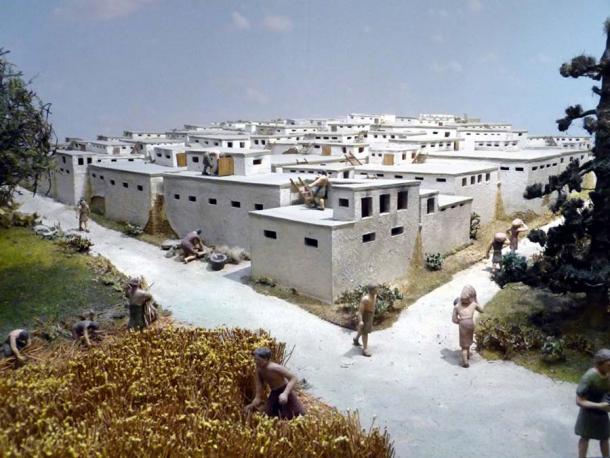
Model of the Çatalhöyük settlement at the Museum for Prehistory in Thuringia. (Wolfgang Sauber / CC BY-SA 4.0)
The Role of Feasting
In a 2008 article in the Journal of Anthropological Archaeology, Katheryn C. Twiss explores the possible role of feasting in the Neolithic Southern Levantine, drawing on insights from other parts of the world and other points in time in the process.
- The 9,500-Year-Old Honeycomb City of Çatalhöyük
- 5,500-Year-Old Neolithic Cranial Amulets Shed Light on Ancient Belief System
She suggests that the importance of cattle as a feast food reinforced their symbolic and cultural value, and -- referencing patterns seen in Çatalhöyük’s Bos remains -- that the increased demand for and cultural meaning of cattle could even have helped compel their domestication or influenced the adoption of domestic cattle into society.
Çatalhöyük East straddles a fascinating -- and momentous -- interval of history. It embodies some defining elements of the human life-world in the Neolithic of Southwest Asia, including sedentism, densely settled living, and an intriguing blend of gathering and farming, hunting, and herding.
Cattle in the form of the large, fierce, free-roaming aurochs and cattle in the form of a smaller, milder, freshly tamed version of that sacred beast -- appear to have been at the center of that hunting-and-herding nexus, and, with their apparently heavy-duty social and symbolic currency, a key to exploring Çatalhöyük society.
Top image: Uncovered bulls head from the northeast platform in building 77 at Çatalhöyük. Source: Çatalhöyük Research Project / CC BY-NC 4.0
By Toni Allen
References
Arbuckle, B. January 1, 2014. “Pace and Process in the Origins of Animal Husbandry in Neolithic Southwest Asia.” Bioarchaeology of the Near East 8: 53–81. Available at: https://www.researchgate.net/publication/268872189_Pace_and_process_in_the_origins_of_animal_husbandry_in_Neolithic_Southwest_Asia
Arbuckle, B. S., and Kassebaum, T. M. May 1, 2021. “Management and Domestication of Cattle (Bos Taurus) in Neolithic Southwest Asia.” Animal Frontiers 11, no. 3: 10–19. Available at: https://doi.org/10.1093/af/vfab015
Arbuckle, B. S., and Makarewicz, C.A. September 2009. “The Early Management of Cattle (Bos Taurus) in Neolithic Central Anatolia.” Antiquity 83, no. 321: 669–86. Available at: https://doi.org/10.1017/S0003598X00098902
Hodder, I. No date. “Studies in Human-Thing Entanglement.” Accessed December 10, 2021. Available at: http://www.ian-hodder.com/books/studies-human-thing-entanglement
Pawłowska, K. January 18, 2020. “Time of Change: Cattle in the Social Practices of Late Neolithic Çatalhöyük.” Archaeological and Anthropological Sciences 12, no. 2: 39. Available at: https://doi.org/10.1007/s12520-019-00961-x
Perkins, D.. April 11, 1969. “Fauna of Çatal Hüyük: Evidence for Early Cattle Domestication in Anatolia.” Science 164, no. 3876: 177–79. Available at: https://doi.org/10.1126/science.164.3876.177
Russell, N., Martin, L. and Buitenhuis, H. December 1, 2005. “Cattle Domestication at Çatalhöyük Revisited.” Current Anthropology 46, no. S5: S101–8. Available at: https://doi.org/10.1086/497664
Russell, N., Twiss, K., Orton, D. and Demirergi, G. 2012. “More on the Çatalhöyük Mammal Remains,” 213–58. Available at: https://www.researchgate.net/publication/261010212_More_on_the_Catalhoyuk_mammal_remains
Twiss, K. C. December 1, 2008. “Transformations in an Early Agricultural Society: Feasting in the Southern Levantine Pre-Pottery Neolithic.” Journal of Anthropological Archaeology 27, no. 4: 418–42. Available at: https://doi.org/10.1016/j.jaa.2008.06.002
















Comments
Boy Howdy! Archeology marches on with new theories. The original theory of bovine worship is changing. I applaud new genetic testing and comparison to wild/ domestic types. This does make sense. But it only brings more questions than answers. Were they in fact worshiped or exploited? Or both? Bovines are a powerful creature for pedestrian human control. But not terribly smart. Were they castrated? Did they use them for draft? Since mudbrick building skill was in use, did they build fences? It seems their town concept of small adjoining rooms filled in and built up, with a plaza type roof would be safe from wandering bullocks and easy to spot approaching herds or even monitor domestic ones. Clearly there is much we don't know. I don't buy the theory that domestication shrunk wild phenotypes. The Iberians have been breeding bulls to be the most fierce aggressive fighting bulls for 3thousand years. Not as big as Orachs, but nuthin domestic about em!
Boy Howdy! Archeology marches on with new theories. The original theory of bovine worship is changing. I applaud new genetic testing and comparison to wild/ domestic types. This does make sense. But it only brings more questions than answers. Were they in fact worshiped or exploited? Or both? Bovines are a powerful creature for pedestrian human control. But not terribly smart. Were they castrated? Did they use them for draft? Since mudbrick building skill was in use, did they build fences? It seems their town concept of small adjoining rooms filled in and built up, with a plaza type roof would be safe from wandering bullocks and easy to spot approaching herds or even monitor domestic ones. Clearly there is much we don't know. I don't buy the theory that domestication shrunk wild phenotypes. The Iberians have been breeding bulls to be the most fierce for 3thousand years. Not as big as Orachs, but nuthin domestic about em!